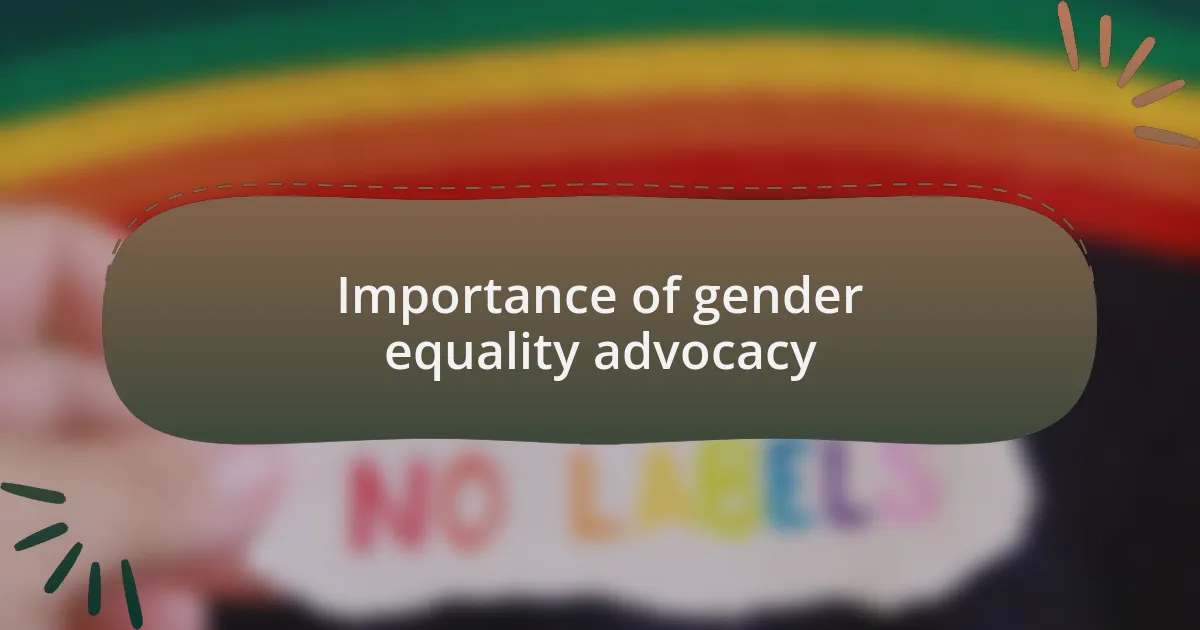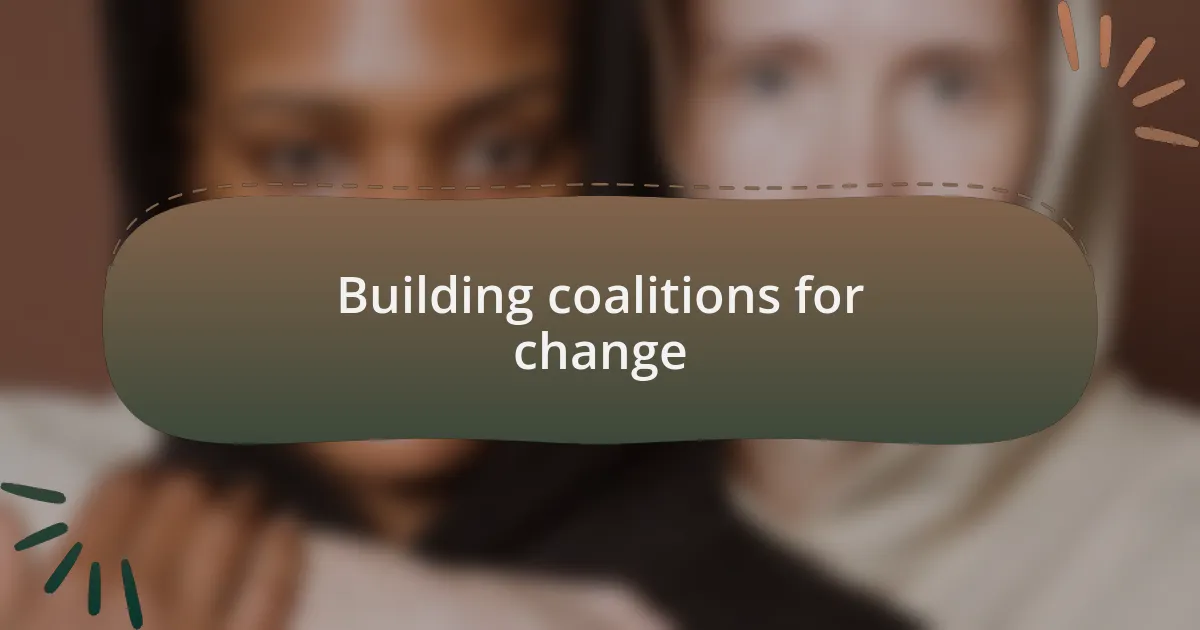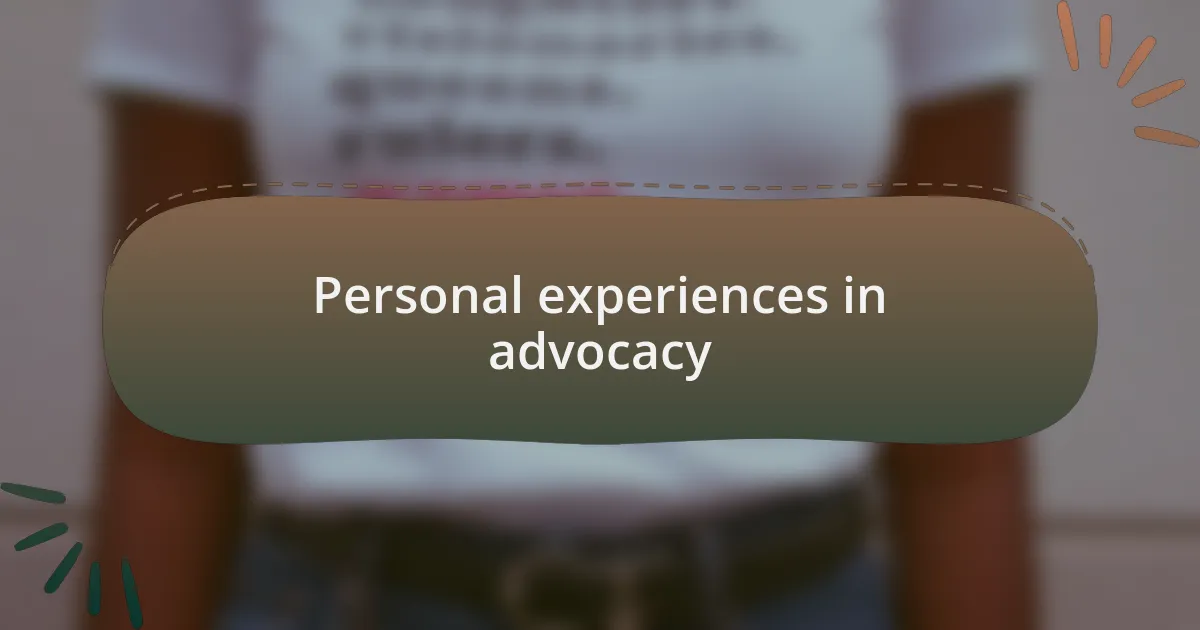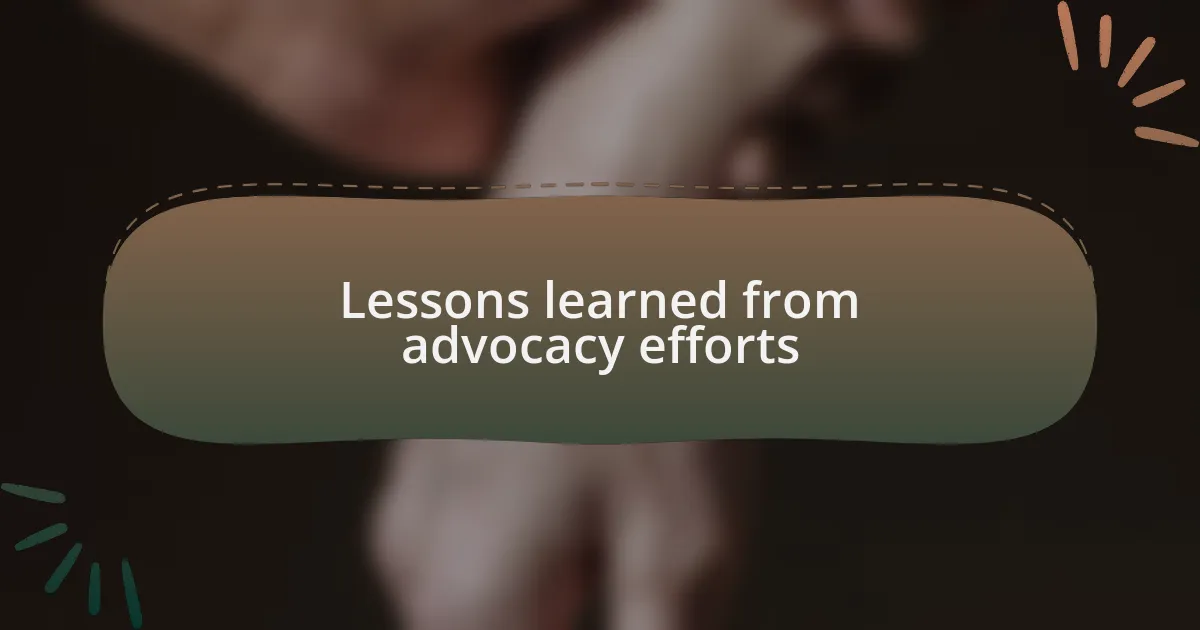Key takeaways:
- Gender bias in legislation often favors one gender, reflecting societal stereotypes and impacting health and caregiving perceptions.
- Advocacy for gender equality is crucial for fair access to opportunities and economic growth, challenging entrenched societal norms.
- Building coalitions across diverse groups enhances advocacy efforts, showcasing the collective power in driving legislative change.
- Personal experiences and storytelling play a vital role in advocacy, helping to humanize issues and connect with decision-makers.

Understanding gender bias in legislation
Gender bias in legislation is often subtle yet pervasive, creating laws that inadvertently favor one gender over another. I remember a time when I came across a policy that granted parental leave to only mothers, reinforcing the stereotype that caregiving is solely a woman’s responsibility. Why is it that we often overlook the fact that fathers also play a crucial role in child-rearing?
In my experience, legislation can reflect societal biases in ways that might not be immediately obvious. For instance, laws surrounding healthcare often fail to consider the unique medical needs of women, leading to inadequate treatment options or research. Have we ever paused to reflect on how this oversight translates into real lives, potentially affecting women’s health outcomes?
Moreover, it’s important to consider how language in legal texts can perpetuate bias. I’ve encountered legislation that uses male pronouns as defaults, which can diminish the visibility of women in legal frameworks. Isn’t it time we rethink our language to foster inclusivity and equality? Each of these facets shows that understanding gender bias is not just an academic exercise but a crucial aspect of advancing gender equality in our legal systems.

Importance of gender equality advocacy
Advocating for gender equality is essential because it ensures that everyone has fair access to opportunities and resources. I vividly recall a workshop I attended where participants shared stories of how legislation impacted their lives. The emotional weight of those shared experiences made me realize how advocacy could change the game for countless individuals, leveling the playing field in ways we often take for granted.
When we push for gender equality in legislation, we’re not just addressing a legal issue; we’re challenging deeply entrenched societal norms. For instance, I often think about how equitable parental leave policies can empower families to make choices based on their unique dynamics rather than outdated stereotypes. Isn’t it time for us to redefine family roles and embrace a more inclusive understanding of parenting?
Moreover, gender equality advocacy can ultimately enhance economic growth. Studies show that when women participate fully in the workforce, economies thrive. I remember collaborating on a project where we analyzed the economic implications of closing the gender gap. It was eye-opening to see that gender equality isn’t just a moral imperative; it’s economically beneficial and can lead to innovative solutions that benefit society as a whole.

Strategies for addressing gender bias
One effective strategy for addressing gender bias in legislation is to incorporate intersectional perspectives in the development process. In my experience, when diverse voices are brought together, the resulting policies often reflect the realities of varied communities. I remember attending a legislative summit where women of different backgrounds spoke about their unique challenges. Hearing their stories highlighted the importance of crafting laws that consider the broader context of gender, race, and socioeconomic status.
Engaging men as allies in the fight against gender bias can also yield impactful results. It’s essential to break the stereotype that gender equality is solely a “women’s issue.” At a recent community event, I was inspired by a father who shared how his support for equal pay was rooted in wanting a better future for his daughters. His perspective reminded me that changing mindsets across genders is crucial for sustainable progress.
Lastly, implementing training programs focused on unconscious bias can effectively shift the way legislation is approached and enacted. I once participated in a workshop that explored implicit biases, and it was eye-opening. The trainers facilitated discussions that challenged my assumptions, forcing me to confront the biases I didn’t even know I had. This kind of awareness is vital for anyone involved in drafting or voting on legislation—after all, policymaking should reflect our collective desire for equality, not outdated biases.

Advocating for inclusive legislation
Advocating for inclusive legislation requires a deep understanding of the lived experiences of marginalized groups. I recall a meeting with local activists where we dissected proposed laws, and it struck me how often the voices of people with disabilities were overlooked. This experience made me realize that inclusive legislation isn’t just about gender—it’s about ensuring everyone’s needs are acknowledged and addressed. How can we truly consider ourselves advocates if we leave anyone behind?
Representation in the legislative process plays a critical role in promoting inclusivity. During a city council meeting I attended, I was moved by the powerful testimonies from transgender individuals advocating for healthcare reforms. Their stories made it apparent that legislation crafted without their input will inevitably miss the mark. It left me wondering: if we genuinely want fair laws, shouldn’t the law-making body reflect the diversity of our communities?
Furthermore, framing advocacy efforts within the context of shared humanity can unite diverse groups. I once joined an interfaith dialogue discussing social justice, and it became clear that while our backgrounds differed, our aspirations for equality were remarkably similar. This shared understanding inspired me to push for legislation that recognizes not just gender, but our collective desire for a fair society. Isn’t it essential that our laws resonate with our common goals rather than divide us?

Building coalitions for change
Building coalitions for change is all about forging connections that transcend individual interests. I remember organizing a workshop where women’s rights activists teamed up with environmentalists to address the disproportionate effects of climate change on marginalized communities. It was enlightening to witness how aligning our passions not only broadened our perspective but also amplified our collective voice in legislative discussions. Isn’t it empowering when diverse advocates unite for a common cause?
In another instance, I found myself collaborating with a group of veterans advocating for disability rights, which opened my eyes to the complexities of navigating both gender and disability biases. As we shared our experiences, I felt a powerful bond forming; it was clear that our struggles, while distinct, were intertwined. This realization reinforced my belief that a coalition’s strength lies in its diversity—each unique voice adds depth to our advocacy efforts. How often do we overlook the power of collaboration in driving real change?
Moreover, I recall a pivotal meeting where we invited community leaders from various backgrounds to discuss strategies for legislative impact. As we brainstormed together, I realized that building coalitions isn’t just about rallying support; it’s about creating a safe space for dialogue and mutual learning. This kind of collaborative spirit is essential in tackling gender bias effectively. How can we risk missing out on the innovative ideas that emerge when we listen to each other’s stories?

Personal experiences in advocacy
Advocacy has a deeply personal dimension for me, especially when I think back to my first experience speaking at a local town hall meeting. I was nervous yet determined to confront the gender wage gap in our municipality. As I stood before a crowd that included policymakers and community members, I realized how important it was to transform my feelings of vulnerability into a powerful message for change. Did that moment resonate with anyone else in the room? I could see heads nodding in solidarity as I shared stories of women struggling to make ends meet.
Another powerful experience unfolded during a panel discussion on domestic violence legislation. I listened to a survivor’s account, which was both harrowing and inspiring. Her courage to speak out encouraged me to share my own experience with advocating for better support services for victims. Those moments reminded me that advocacy isn’t just about data and statistics; it’s also about humanizing the issues. How can we expect change if we don’t put faces and stories behind the policies?
I also recall a time when I was part of a community-focused initiative aiming to amplify the voices of young girls in our city. We gathered at community centers, inviting them to share their dreams and challenges. Hearing their raw honesty struck a chord in me—it highlighted the need for legislation that genuinely reflects their experiences. I couldn’t help but wonder if we could harness their energy and aspirations to craft a new wave of advocacy that prioritizes their needs. Wouldn’t it be transformative if they played a significant role in shaping the policies that affect their lives?

Lessons learned from advocacy efforts
When advocating for gender equity in legislation, one core lesson I’ve learned is the power of collaboration. I remember a moment during a coalition meeting where diverse groups came together to strategize on legislative proposals. The synergy of ideas and experiences inspired me and underscored a vital truth: collective voices are often louder and more compelling than any single perspective. Have you ever experienced the energy that comes from a united front? It’s truly motivating.
I’ve also come to understand that persistence is key. I recall passionately advocating for a bill aimed at establishing equal parental leave, only to face multiple setbacks. Each rejection felt disheartening, yet I learned that resilience in the face of obstacles often paves the way for eventual success. It made me question how often we give up too soon. Imagine the change we could foster if we dedicated ourselves to pushing through those tough moments.
Lastly, I learned that storytelling is an invaluable tool in advocacy. While attending community forums, I witnessed firsthand how sharing personal experiences could shift perspectives and foster empathy. One woman’s story about balancing career and caregiving resonated deeply with everyone present. It reminded me that relatable narratives can create lasting connections with decision-makers. Have you ever felt a story move you to action? This connection is what turns advocacy into a meaningful dialogue, empowering us all to become agents of change.